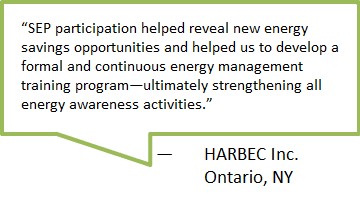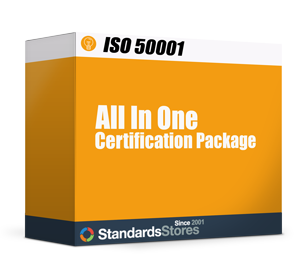Superior Energy Performance – SEP
The U.S. Department of Energy’s (DOE) Office of Energy Efficiency and Renewable Energy, explains Superior Energy Performance® (also known as SEP®) as follows:
Certifying Increased Energy Productivity under ISO 50001
Facilities certified to Superior Energy Performance® (SEP®) are leaders in energy management and productivity improvement. The facilities in SEP have met the ISO 50001 Standard and have improved their energy performance by up to 30% over three years.
To become certified, facilities must implement an energy management system that meets the ISO 50001 standard and demonstrate improved energy performance. An independent third party audits each facility to verify achievements and qualify it at the Silver, Gold, or Platinum level, based on energy performance improvement. This certification emphasizes measurable savings through a transparent process.
TWO VERSIONS OF THE SEP PROGRAM ARE AVAILABLE: Updated SEP program requirements and documents are now available. Organizations may use SEP 2012 or SEP 2017 for initial certification or recertification. View the SEP Program Documents and Resources List for SEP 2012 and SEP 2017 (with version/revision dates).
SEP-certified facilities note that investing the extra effort in SEP—beyond ISO 50001—is clearly worth it. Cost-benefit assessments find that SEP helps facilities in a wide range of industries and large energy users. Results to date:

- Annual savings of $36,000 to $938,000 using no-cost or low-cost operational measures
- 12% reduction in energy costs within 15 months of SEP implementation (on average)
- 6% to 30.6% improvement in energy performance over three years
- Paybacks of less than 1.5 years (in facilities with energy costs > $2 million annually).
An energy management system (EnMS) helps a facility establish the policies and procedures to systematically track, analyze, and improve energy efficiency. Learn more about energy management using ISO 50001.
The SEP program was designed to drive systematic energy performance improvement across the U.S. manufacturing and commercial buildings sectors—significantly reducing energy use and carbon emissions. It was developed with active participation by industry members of the U.S. Council for Energy-Efficient Manufacturing (U.S. CEEM) and is currently administered by the U.S. Department of Energy (DOE). Audits are performed only by SEP Verification Bodies accredited by the American National Standards Institute (ANSI)-ASQ National Accreditation Board (ANAB). DOE provides recognition to facilities certified to SEP.
SEP and ISO 50001 Certification Process
Superior Energy Performance (SEP) certification is the U.S. Department of Energy’s (DOE) certification based on a portfolio of standards and protocols developed by experts from industry, national standards organizations, federal agencies, and academia. These collaboratively developed requirements ensure broad applicability across industry and confidence that certified organizations have indeed achieved a measure of excellence agreed upon by a discerning community.
The DOE has developed detailed steps and free online resources- Enroll, Prepare, Apply, Verify. If you follow these steps it will help your organization reduce energy costs, regardless if your organization is ready for certification or just beginning to implement ISO 50001 requirements.
The four steps are defined as:
Enroll – View the SEP and ISO 50001 introductory materials
Prepare – Install an energy management system, Review how to qualify for SEP certification, Access the SEP standards and protocols
Apply – Find a verification body, Auditing fees for SEP certification
Verify – Undergo an audit, Recognize achievement, Recertify
ENROLL
If you are interested in becoming SEP certified, the first step is to enroll. Enrolling allows you to gain access to resources for streamlining the SEP implementation process. If you are interested in enrolling, download the enrollment form and sign up today.
PREPARE
Preparation involves establishing an EnMS in your organization. This EnMS must meet the ISO 50001 standard requirements. To generate the greatest savingings learn more about ISO 50001:2018, learn how to qualify for SEP, and access SEP standards and protocols.
APPLY
When you are ready to undergo the SEP audit, you should submit your application to the SEP Administrator. You need to find a find a Verification Body to conduct the audit. After verifying that SEP requirements are met, the Verification Body will issue both the ISO 50001 and SEP certificates. DOE will then recognize your SEP certified organization.
Is your organization ready to apply for SEP certification?
☐ EnMS in conformance to ISO 50001 is in place
☐ Energy performance improvement has been achieved and meets the SEP Measurement and Verification Protocol requirements
☐ Requirements in ANSI/MSE are met
☐ Ready for the audit to verify the items above
☐ Verification Body selected
☐ If applicable, forms for pre-approvals for alternative approaches are complete or already submitted
Apply today:
- Download and complete the SEP application
- Submit the application or ask questions: superiorenergyperformance@ee.doe.gov
- Currently, no fees are charged for applying to SEP.
After you submit your application, the SEP Administrator will review the application to assure completeness. The SEP Administrator will notify you as soon as the application is approved and will then send the approved application to your chosen SEP Verification Body.
FIND A VERIFICATION BODY
For SEP certification, you may select an accredited SEP Verification Body or applicant Verification Body to conduct the audit.
You may choose to pursue only ISO 50001 certification, but if there is a chance that your organization will pursue SEP certification in the future, consider choosing an SEP Verification Body now to minimize SEP audit costs later.
Organizations hire a SEP Verification Body to conduct the audit and payment goes directly to the auditor. Please contact the Verification Bodies to inquire about their auditing rates and fees. Currently, no administrative fees are charged by the SEP administrator for applying to SEP.
VERIFY
Verification to SEP is similar for ISO 50001. The biggest difference is that SEP requirements beyond the EnMS standard are also audited. If you want to be certified to both SEP and ISO 50001, only ANAB accredited SEP Verification Bodies can certify organizations to SEP using an audit team of a qualified lead auditor and SEP Performance Verifier(s) during the audit.
The number of days necessary to conduct both audits varies depending upon the complexity of the organization and whether the organization is already certified to ISO 9001 or ISO 14001. The minimum number of audit days for ISO 50001 certification can range from 5.5 to 9 audit days, and for SEP those numbers increase slightly, ranging from 6 to 13 audit days.
The audit process to become SEP certified begins once the SEP administrator sends your approved application to your chosen SEP Verification Body.
The SEP verification Body selects the audit team, this includes a certified SEP Lead Auditor and a Performance Verifier—to conduct the two-stage audit:
- To minimize costs and delays, the Stage 1 audit, confirms that your organization is prepared for the Stage 2 audit. This can either be done on-site or remotely.
- State 2 audit consists of the SEP audit team visiting your organization to determine whether the organization conforms to ISO 50001 and ANSI/MSE 50021, and further to verify your energy performance improvement using the SEP Measurement and Verification Protocol and, if applicable the SEP Scorecard.
After the audit: The SEP Verification Body will issue the SEP and ISO 50001 certifications. If the Verification Body finds that your organization does not conform to the requirements, it will issue corrective actions that your organization must complete before receiving SEP certification.
SEP certification is valid for three years, as long as your organization completes the annual surveillance audits to confirm continued maintenance of the EnMS (a requirement of ISO 50001).
Recognize Achievement
If your organization achieves SEP certification, this is considered a significant accomplishment and your organization will receive recognition from the U.S. DOE, SEP Administrator. Additionally, the DOE will provide a certificate of achievement and promote the accomplishment on their website that organizations can share.
Recertify
To continue SEP certification beyond three years, you must apply for recertification. The recertification audit may not require a Stage 1 audit unless significant changes occurred since the previous certification.
To recertify, you need to submit the SEP application six months prior to the expiration of your current SEP certificate to avoid any lapse in certification. If the SEP certificate expires before your organization is recertified, the full certification process including the Stage 1 audit is required.
DOE is the administrator of the SEP certification program. For questions, contact superiorenergyperformance@ee.doe.gov.
This information was provided by The U.S. Department of Energy’s (DOE) Office of Energy Efficiency and Renewable Energy.


